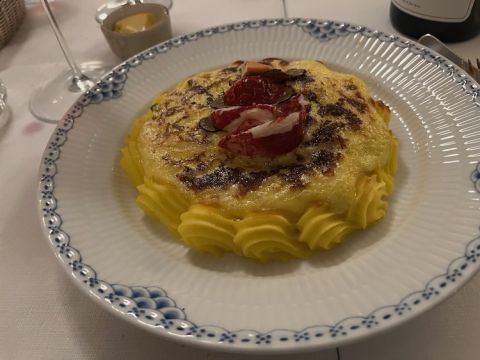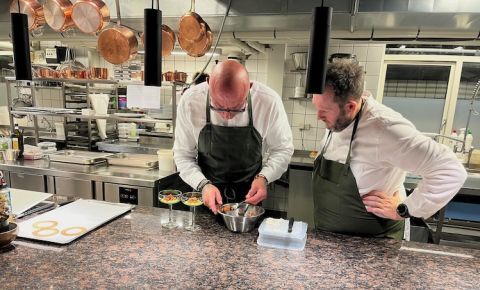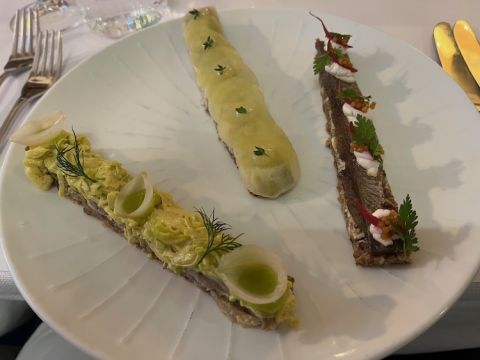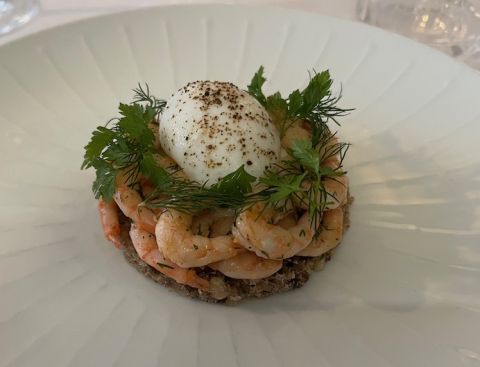Citizens of almost every country in the developed world can feel proud of their country’s achievements in cooking and hospitality over the past 30 years. Few, however, have achieved quite as much as Denmark.
I visited this small country frequently in the late 1970s when, other than herring and open sandwiches, the food was pretty dreary. Today the restaurant scene in Copenhagen is thriving – in no small way due to René Redzepi and the influence of his famous restaurant Noma that effectively introduced Nordic cuisine to the world. And, thanks to global warming, Denmark is even making some fine red wine.
The proof came as we settled into our table at the bustling Møntergade restaurant in the centre of the city last weekend. Having been made very welcome by one of its owners, Simon Olesen (a sort of modern Friar Tuck), we asked this repository of wine knowledge whether it would be possible to taste a Danish wine. ‘Certainly’, came his reply, adding somewhat surprisingly that he reckoned the reds were better than the whites.
He brought us an Isso Pinot Noir 2020 from a producer called Njord that was perfumed and elegant, and in my view in fact more evocative of Pinot than even England’s most successful Pinot from Danbury Ridge in Essex. ‘He only makes eight to ten barrels a year,’ Olesen continued, ‘so it’s expensive.’ In fact at 775 kroner a bottle, it almost as expensive as the extremely lovely bottle of Bourgogne Rouge 2020 from Koji Nakada and Jae Hwa of Gevrey-Chambertin (whose négociant label is Lou Dumont and cost 800 kroner) which we eventually chose.
This was all after a great deal of dithering thanks to the restaurant’s wine list, which is extensive, admirably fastidious, wide-ranging, and extremely fairly priced by the standards of Denmark where VAT at 25% is levied on everything. It begins, for example, with a couple of pages devoted to Champagne, including quite an offering of Selosse wines. It continues with numerous German wines of varying vintages from top addresses. Chardonnays from Matthiasson in California and The Eyrie Vineyards in Oregon and a good range of Sadie Family wines from South Africa follow. There is also a wide range from Burgundy, a region which Olesen visits every year. Several of the names were new to Jancis, which is always encouraging. (His partner, Rasmus Amdi, spoke warmly of the man in charge of the restaurant’s underground cellar – this must be a formidable job!)
Møntergade, which takes its name from the street, opened initially across the road on a site that is now a cocktail bar run by the same team. In 2020 they were approached by the owners of the current site who wanted to retire and they soon purchased it, inheriting a building equipped with a great deal of crockery and – particularly noticeable – an enormous quantity of French Apollonox knives. This site has been the scene of welcoming hospitality since the 1980s. (Noma were having their staff Christmas lunch here the following day.)
I feel quite sorry for restaurant kitchens in December. They have to cope with extra numbers but still try to maintain their philosophy. One way of managing this is to limit the menu, but that puts a heavy responsibility on each dish. This was the approach taken here and it worked with my first course but was less successful with my main course. After a delicious dish of duck hearts on a skewer, served alongside a croustade of morels (a gift from the restaurant), I began with a veal sweetbread rolled and placed on top of cheesy aligot potato purée and topped with white truffle (265 kroner) enriched with a heavily reduced sauce that was ideal for the Bourgogne Rouge.
My main course was lemon sole Walewska, a dish I’d last seen on a Wheeler’s menu in London in the 1980s and apparently named after Marie Walewska, Napoleon’s mistress. The fish is filleted, steamed and then served with spinach and topped with pommes duchesses, some slices of Danish lobster and black truffle and a rich mornay sauce (béchamel enriched with gruyère). This is then browned under a salamander before being served. I managed a creditable half.
We shared a rice pudding – a traditional Danish dish for Christmas – that was served alongside a dish of warm cherries. (My bill for two with one bottle of wine came to 2,200 kroner, about £250.)
Perhaps we should have followed the drinking patterns adopted by every other table. This Saturday evening seemed extremely popular with Danish men (very few women were present) who, while loudly enjoying both the company – workmates? – and their food, seemed to be drinking predominantly beer and schnapps, leaving the bottles on this restaurant’s glorious wine list to us wine lovers.
Another way in which restaurant kitchens can cope with extra demand at Christmas is not to change at all and rely on well-worn routine, a tactic adopted by Allan Schultz, the chef and inspiration behind Parsley Salon (see main image) in the basement of the Park Hotel in Hellerup, a prosperous northern suburb of Copenhagen. Designed to seat no more than 24 at six tables, the restaurant the night after our visit would be closed for a private party of just 10 people.
Schultz (pictured on the left above), born in 1965, is a highly experienced chef and manager who has worked in many top Danish restaurants. One of his mentors, chef Erwin Lauterbach, used to run the restaurant upstairs from what is today Parsley Salon (which was then a space used for preparation). In 2021 Schultz, along with his obviously loyal ‘plongeur’ Pavel, began its transformation. When I asked Schultz whether he had any business partners, his response was resolute, ‘No. I saved up, borrowed money and basically built the kitchen myself’. In the process he uncovered an English, hand-painted cow-parsley wallpaper that gives the restaurant half its name. The other half comes from the intimate atmosphere he and his experienced sommelier Alexander Berntsen deliver.
Down a flight of stairs, past an open kitchen overhung with copper pans, is a marble counter that doubles as a bar, with a TV screen showing a hearth burning logs. It warmed us on this icy night while we enjoyed a glass of champagne and three delicious canapés. The most dramatic was a take on a caprese salad: a coupe of tomatoes in basil cream topped with a ring of particularly flavourful mozzarella and a lattice ring very obviously informed by mature parmesan.
We were then taken across to the main part of the restaurant which has the most elegant, obviously Danish, chairs and tables, and presented with a menu. (The sensitive, flexible lighting is a bonus.)
The set menu comprises eight ambitious courses (predictably, one too many) at 1,250 kroner with a seven-glass wine tasting menu at 850 kroner. It opened with a combination of oscietra caviar and aubergine, then progressed via a langoustine on seaweed with tangy beurre blanc, a crimson cod-and-beetroot ravioli, a piece of Icelandic salmon (pictured below), and then a barbecued octopus tentacle. Meat then made its sole appearance, a piece of rabbit fillet with carrot (a parody on rabbit food) before two desserts of which the quince sorbet with cubes of three different house made fruit jellies was the standout.
All of this was enhanced by delightful service from Ejvind Arvidsen, the most experienced waiter in Denmark, having begun this career in 1969, and the wit and intelligence of Bernsten. This brief trip to Copenhagen was inspired by having met the Parsley Salon team when they won this year’s Copa Jerez food-and-sherry-matching competition in October (and pressure to take advantage of a British Airways companion voucher before it expired). It was not surprising therefore that among Bernsten’s choices were a couple of glasses of sherry, a Manzanilla from Bodegas Barón in Sanlúcar and an Oloroso from Callejuela. Other real hits were the 2020 Flor de Muga Rioja Blanco and, especially, the Ch de Rayne Vigneau 2006 Sauternes that was absolutely knock out. I paid a bill of 3,350 kroner for a truly memorable evening in an establishment very obviously aiming for a Michelin star.
Today, any Dane in the restaurant business starts with two advantages. The first is that the Danish language has a word for the type of atmosphere they would like to generate, hygge. This roughly translates as the quality of comfortable conviviality that their customers will enjoy.
The second is that their predecessors have done a great deal of hard work in getting rid of the disdain in which good food was once held in Denmark. The effects of German occupation during the war; of the de-skilling encouraged at one point by management accountants; of the desire to produce quantity over quality – all these were erased during the decades of the 1990s and 2000s.
One other restaurant to offer hygge combined with elegantly presented good food is the restaurant in which the composer Carl Nielsen once lived and that still bears his name. Here, my passions for herring and open sandwiches were completely satisfied. At an early Saturday lunch I ordered what was described as Carl Nielsen’s herring plate – three fingers of thin rye bread with three different herring toppings – and Carl Nielsen’s plate of egg and shrimp: a circle of rye bread topped with sweet, peeled tiny prawns topped in turn with a delicious soft-boiled egg.
I paid a bill of 1,300 kroner for the three of us and left feeling very Danish.
Møntergade Møntergade 19, 1116 Copenhagen; tel +45 33 33 06 10
Parsley Salon Strandvejen 203, 2900 Hellerup; tel +45 24 21 21 62
Restaurant Carl Nielsen Toldbodgade 5, 1253 Copenhagen; tel +45 70 25 16 25





















